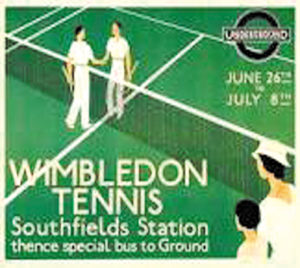 By Robert Reed
By Robert Reed In the wide world of sports tennis has been relatively under collected in the past, but it has a winner’s potential in the future. Today tennis “meets all the criteria” of a popular sporting collectible according to author Robert Everitt. Writing in the very comprehensive volume, Racket Sports Collectibles, Everitt notes tennis has the heritage, the players, and the coverage. Not surprisingly it also has the memorabilia or what some would call the stuff.
Fans of paper collectibles can find programs, tickets, catalogs, magazines, and books. Others might look for vintage rackets, clothing, containers, and other equipment. Additionally there are photographs, autographs, and even trophies of past tennis glory.
Historically tennis can be traced back to 12th century France where it was practiced in a more primitive form. During the latter part of the 19th century it was revised and refined in England into the ’new’ game of lawn tennis. Accounts vary but most credit Major Walter Wingfield with a patented game of tennis in 1874 with giving the sport a major boost. Most of Wingfield’s rules were accepted although the idea of an hourglass field was soon changed to a rectangular field when tournament play began in the late 1870s.
The first United States Open tennis tournament took place in 1881 at Newport, Rhode Island. During that decade the sport was popular enough to prompt the mass production of tennis player figurines in Germany. Typically the bisque figures were in full uniform that period including high socks, draped collar, and cap.
By the 1890s even the awards for winning tennis were getting more elaborate. An example was the Lawn Tennis Championship of Ireland. The winner received a silver tray with scrolled leaves engraved by L. West of London. In recent years the 30-inch wide original sold at Leland’s Auctions in the United States for more than $5,000.
 An enterprising American named Dwight Davis organized the first Davis Cup tennis competition in 1900. The U.S. team defeated the British team during the first year of the event held in Boston. Today programs of the early Davis Cup championships are highly prized. A string-bound Davis Cup Souvenir program booklet of 1913 recently fetched several hundreds dollars at a major auction house.
An enterprising American named Dwight Davis organized the first Davis Cup tennis competition in 1900. The U.S. team defeated the British team during the first year of the event held in Boston. Today programs of the early Davis Cup championships are highly prized. A string-bound Davis Cup Souvenir program booklet of 1913 recently fetched several hundreds dollars at a major auction house. Tennis rackets are also making a ‘racket’ with collectors too. On occasion early rackets still turn up including those made by A.W. Gamage of London in the 1890s and those made in the early 1900s by Wright and Ditson of Boston. Another favorite with collectors is the Dayton brand wooden tennis racket of the 1920s.
“The condition of a (early) racket is not everything to a collector, but the appearance of it does help to persuade someone it is worth investing in,” notes author Everitt. “Very often, a racket’s strings can be in terrible condition, but the piece has some other rare and desirable detail, which makes their condition of little importance.”
The second half of the 20th century saw a gradual move from the traditional wooden tennis racket to rackets of metal and later graphite and additional materials. Today many surviving wooden rackets in good condition are considered both decorative and collectible.
Tennis moved to the silver screen early in the 1920s with an instructional movie titled The Art of Tennis. The film featured female members of the British Davis Cup Team and their French challengers. One of the stars was French great Susanne Lengelen and her partner Elizabeth Ryan. Posters of the movie made by the Parkstone Film Company are treasured today.
Tennis players in general, and women player in particular were often memorialized on magazine covers of the early 20th century. Notable among them were Collier’s , the Sunday Magazine of the New York Tribune, and the Saturday Evening Post.
 During the 1920s tennis star Helen Wills made the cover of Time magazine twice, and books like Tennis in Baltimore by Frank Roberts were favored reading. In 1931 the Lawn Tennis Association published the unique volume, Fifty Years of Lawn Tennis in the United States. The hardcover edition reviewed the previous five decades of the remarkable sport in this country.
During the 1920s tennis star Helen Wills made the cover of Time magazine twice, and books like Tennis in Baltimore by Frank Roberts were favored reading. In 1931 the Lawn Tennis Association published the unique volume, Fifty Years of Lawn Tennis in the United States. The hardcover edition reviewed the previous five decades of the remarkable sport in this country. Tennis was back in the movies during the 1940s when tennis star Alice Marble appeared in the film Tennis in Rhythm. Previously Marble had been featured on the cover of Life magazine. By post World War years of the 1940s tennis balls for the popular game were regularly being sold some places in cans, and eventually the containers became a fond collectible.
In recent years the Official Guide to Flea Market Prices by Harry Rinker devoted a section to tennis ball cans alone. Rinker noted that previously tennis balls were sold in bags or cardboard boxes before the innovation by Wilson. A good example of such cans in prized and unopened condition, would be the Wilson Match-Point container produced in 1945.
A breakfast cereal gave unique recognition to the sport of tennis early in the 1950s, not to mention the black female athlete. In 1952 Wheaties featured a select group of professional athletes on the backs of cereal boxes to cutout as trading cards. In the group a number of baseball players, golfer Sam Snead, and tennis sensation a Athea Gibson. A few years later Gibson also made the cover of both Time magazine and Sports Illustrated, but the earlier achievement on the cereal boxes had far greater impact on the youngsters of that generation. The enduring Arthur Ash became a tennis legend in the 1960s and was fittingly on the cover of many magazines including Sports Illustrated and Life. Early in the 1970s professional tennis got a tremendous boost when Billie Jean King and Bobby Riggs staged the grand Battle of the Sexes before a nationwide television audience. Tennis became a child’s game too during the 1970s when XV Productions marketed Set Point-The Tennis Strategy Game and Parker Brothers offered a game simply named Tennis.
Eventually collectors moved on to even more exotic tennis collectibles such as the game worn jacket of John McEnroe and action photographs of Boris Becker or Martina Navratilova. Autographs of tennis wonders of the past as William “Big Bill” Tilden were treasured, and the even the signatures of more contemporary idols Steffi Graf and Monica Seles seriously sought.
Tennis is “another sport where the collectibles are starting to command increased attention,” note Don Johnson and Ellen Schroy the co-authors of Warman’s Flea Market Price Guide, 2nd edition. They suggest looking for ephemera and equipment endorsed by famous players such as a Poncho Gonzales tennis ball can or a color illustrated Maureen Connolly tennis racket.
Recommended reading: Racket Sports Collectibles by Robert Everitt (Schiffer Publishing).















Follow Us